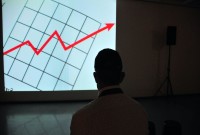- Home
- Business Processes
- Industry Knowledge
- Aerospace Industry
- Automotive Industry
- Banking Domain
- BFSI Industry
- Consumer/ FMCG Industry
- Chemicals Industry
- Engineering & Construction
- Energy Industry
- Education Domain
- Finance Domain
- Hospitality Domain
- Healthcare Industry
- Insurance Domain
- Retail Industry
- Travel and Tourism Domain
- Telecom Industry
- Leadership Skills
- eLearning
- Home
- Leadership
- Leadership Theories
- Taylor’s Scientific Management
Taylor’s Scientific Management
Taylor’s theory of scientific management aimed at improving economic efficiency and labor productivity. Taylor had a simple view that money motivated people at work. He felt that workers should get a fair day's pay for a fair day's work, and that pay should be linked to the amount produced. He introduced the differential piece rate system, of paying wages to the workers.
The industrial revolution provided the impetus for developing various new approaches to increase the productivity and efficiency of the workers. Taylor during 1856 and 1915 propounded that there is a need for developing a scientific way of performing each job and workers should be trained to perform that particular job in a scientific way. Harmonious relations should be developed between management and workers to ensure that the job is performed in the desired way. This led to the management theory known as principles of scientific management.
This theory is a Classical management theory that is based on the belief that workers only have physical and economic needs and prescribes specialization of labor. Classical theories recommend centralized leadership and decision-making and focus on profit maximization. Three streams of classical management theory are - Bureaucracy (Weber), Administrative Theory (Fayol), and Scientific Management (Taylor).
Principles of Scientific Management
Four Principles of Scientific Management are:
- Time and motion study: Develop a science for each element of the job to replace the old rule of the methods. Study the way jobs are performed and find new ways to do them.
- Training: Scientifically select employees and then train them to do the job as described in step-1. Teach, train, and develop the workman with improved methods of doing work. Codify the new methods into rules.
- Supervision: Interest of employer & employees should be fully harmonized so as to secure mutually understanding relations between them. Supervise employees to make sure they follow the prescribed methods for performing their jobs. Continue to plan the work but use workers to actually get the work done.
- Differential Rewards: Establish fair levels of performance and pay a premium for higher performance.
Taylor's scientific approach resulted in a piece-rate incentive system, and the time-and-motion study.
Taylor's Differential Piece Rate Plan:
Taylor felt that the wage system was one of the major reasons for soldiering. To resolve this problem, he advocated the use of a piece-rate incentive system. The aim of this system was to reward the workers who produced the maximum out-put. The system proposed:
- If Efficiency is greater than the defined Standard then workers should be paid 120 % of the Normal Piece Rate.
- If Efficiency is less than standard then workers should be paid 80% of the Normal Piece Rate.
Time and Motion Study:
Taylor also tried to determine the best way to perform each and every job. To achieve this objective, he introduced a method called time-and-Motion study. In this method, a large production job was broken down into various small tasks or motions and unnecessary motions were removed to find out the best way of doing a job. A motion study involves finding out the best sequence and the minimum number of motions needed to complete a task.
After Taylor, Frank and Lillian Gilbreth made numerous contributions to the concepts of scientific management. Frank and Lillian were mainly involved in exploring new ways of eliminating unnecessary motions and reducing worker fatigue.
- Frank Gilbreth (1868-1924) is considered the "father of motion study"
- Lillian Gilbreth (1878-1972) contributed to studies pertaining to motion.
Limitations of Scientific Management:
Although Scientific Management Theory has been instrumental in providing various valuable insights into the development of management thought. In spite of the numerous contributions made by scientific theory, given below are the few limitations:
- The principles of scientific management focus on solutions from an engineering point of view rather than a managerial point of view
- The entire theory is based on the assumption that humans are rational and motivated primarily by the desire for material gain. It overlooks the social and emotional needs of workers and overstressed their economic and physical needs
- The human desire for self-actualization and job-satisfaction (working conditions, job content, etc.) is ignored by the theory
Suggested Reading and Resources
Related Links
You May Also Like
-
There are four major factors in leadership called Leader, Follower, Communication, and Situation. The success of the leader is dependent on how the leader is effectively able to communicate and motivate followers to perform desired tasks using the appropriate leadership style best suited for the given situation. Interdependencies and dynamics of these four factors of leadership must be considered by a leader to be effective.
-
All the teams are dynamic in nature and they take time to come together, they form, develop, and grow in stages, over a period of time. Teams go through five progressive stages: Forming, Storming, Norming, Performing and Adjourning. In this article, we want to introduce you to these stages of team development and certain strategies that you can use to help the team grow and develop in each of these stages.
-
In today's business world, proficiency in management skills is essential for career growth and success. Managerial skills can be defined as attributes or abilities that are essential for every leader and manager to succeed and fulfill specific tasks expected from them by the organization.
-
The ten most important qualities that define a good leader are self-awareness, interpersonal and communication skills, ethical values, organizational consciousness, self-confidence, adaptability and flexibility, imagination and creativity, focus & result-orientation, continuous self-development and accountability and ownership for his actions. These ten qualities of leadership every good leader should possess to a certain extent and must continually strive to develop them.
-
Hawthorne Studies - Leadership
The Hawthorne studies were conducted on workers at the Hawthorne plant of the Western Electric Company by Elton Mayo and Fritz Roethlisberger in the 1920s. This study established the behavioral change that happened due to an awareness of being observed, resulting in active compliance with the supposed wishes of researchers, because of special attention received, or positive response to the stimulus being introduced.
-
Management Principles by Fayol
Henri Fayol (1849-1925), a French industrialist and a prominent European management theorist, developed a general theory of management. Fayol outlined the fourteen principles of management.
-
Max Weber gave the theory of Bureaucratic Management in 1915. Bureaucracy is a specific form of organization defined by complexity, division of labor, professional management, and hierarchical management control. Weber's theory has two essential elements - organizational hierarchy and rules-based management. Weber made a distinction between authority and power and advocated that authority must be given to the most competent and qualified people.
-
Emergent leadership occurs when a group member is not appointed or elected as leader, but rather that person steps up as the leader over time within-group interactions. Have you ever faced challenges in getting accepted into your new role of position as a leader? Groups don't automatically accept a new "boss" as a leader. Emergent leadership is what you must do when taking over a new group. Learn more about emergent leadership.
-
Have you ever resonated that there seem to be as many different ways to lead people as there have been great leaders? When we recall the success of Mahatma Gandhi, Nelson Mandela, Abraham Lincoln, Napoleon Bonaparte to Steve Jobs and Jack Welch, we also notice that they all used different approaches that were suitable to their specific situations and circumstances. Over the last century, researchers and psychologists have developed simple ways to describe the “Styles of leadership” and in this section, we will explore these commonly known leadership styles.
-
Quantitative Theory of Management
The quantitative management approach is given by the mathematical school that recommends the use of computers and mathematical techniques to solve complex management issues and assist in the managerial decision-making process. Managers observe historical quantitative relationships and use quantitative techniques such as statistics, information models, and computer simulations to improve their decision making.
Explore Our Free Training Articles or
Sign Up to Start With Our eLearning Courses

About Us
Learning
© 2023 TechnoFunc, All Rights Reserved










